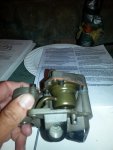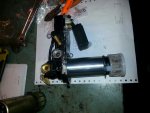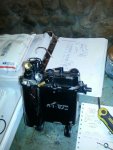No Title
So here is some background on my situation....
I just replaced the engine in my Pursuit with a re-manufactured long block from Rapido Marine in Florida. (1996 5.7LX EFI)
My engine had the 880 block with the non-vortec heads (12 bolt intake manifold). My original engine had a mechanical fuel pump which fed fuel to the VST tank. (This not a cool-fuel set up) Rapido made up the long block but was not able to find the 880 block with the mechanical fuel pump provision. So I converted the low pressure fuel pump to a marine-grade electric fuel pump (CRT model #4389).
I put the engine together with new OEM manifolds and risers, timing cover, water circulating pump, plugs, wires, rotor, distributor cap, filters etc, and installed it. I checked alignment and set the base timing. The motor fired right up and ran well for the 10 hour break-in although I noticed it was getting harder to start when warm and it would only reach 4,150 rpm at WOT. (Target WOT 4,400-4,800 rpm). The old motor would easily reach 4,600 rpm. I began to notice a slight miss that seemed like I had a loose plug wire. I checked the plugs and wires and all were good. I did a compression check and all cylinders were right on 150.
Next I turned my attention to fuel pressure. I purchased a M/C TBI fuel pressure fitting part # 91-806901 online for about $30. This fits into the pressure line from the VST to the throttle body and has a Schraeder valve to attach a fuel pressure gauge. I went to Autozone and ?borrowed? a fuel pressure test kit. (This is a great tool loaner program?You ?purchase? the tester for $159 and you can use it for up to 3 months and "return" it for a full refund. I used this program for a harmonic balancer removal tool, harmonic balancer install tool and an oil pump primer tool too.)
My system is supposed to operate at a constant 30 psi and once it is pressurized it should hold pressure for quite some time after shutting the key off. Mine would pressurize to about 12 psi without cranking the engine and loose pressure immediately upon shutting off the key. At this point I knew I had a fuel pressure issue. When I cranked the starter the pressure would build in a few revolutions until the engine would start once the fuel pressure reached about 25 psi. The engine seemed to run well and the fuel pressure would stabilize at just under 30 psi. Then randomly the fuel pressure would suddenly drop and the engine would die. (Thankfully this never happened during the first 10 hours of operation.) The engine would restart after lots of cranking once the fuel pressure climbed back up to 25 psi. If I shut the engine down while it was running the fuel pressure also dropped immediately to zero. (Again not normal).
I checked the fuel lines and vent for obstructions and I replaced the fuel filters and checked the pressure and flow from the low pressure electric fuel pump to the VST?.all normal. The gas is fresh and is the same tank I ran for the 10 hour break-in. I blocked the return line from the throttle body to the VST as per the Service Manual and cycled the pump on via the ignition. The Service Manual says that if the pressure climbs above 30 psi replace the pressure regulator. If the pressure does not climb above 30 psi replace the fuel pump. Mine climbed to 50 psi (still dropped quickly to zero after turning off the key). Based on that result I was trying to locate the fuel pressure regulator M/C part # 852955 (list price $206) that I mentioned in my first post. They are not available so I found the $26 GM TBI rebuild kit that I installed. (Glad I couldn?t find the regulator after all). After putting it back together, I had the same symptoms but at least I eliminated the regulator and the throttle body has new O-rings, gaskets, pressure regulator diaphragm, injector screens, etc.
The Service Manual goes on to say that a sudden loss of fuel pressure can be caused by three things?bad fuel pressure regulator (mine is good), leaking injectors (no leaks), or a bad check valve on the VST fuel pump. So I removed the VST tank and disassembled it. It looked good inside, no gunk or debris and float and needle valve look good. The pump itself is a sealed unit so I can?t really tell anything by looking at it but I decided to replace it as the diagnosis points to it. The OEM pump is available from M/C part # 827682T with a list price of $786 OUCH!!! The VST O-ring gasket kit part # 808500 is available with a list price of $98 Yikes!
After some digging I was able to find an aftermarket pump online that claims to be a direct replacement for part # 827682T at $70 with free shipping!!!!. The pump is made by HFP (part # HFP-512). It comes complete with O-rings and seals, screen filter, electrical connection posts and a lifetime replacement warranty. (It is available from several vendors online). I know it sounds too good to be true but I have one on order and should receive it by the end of the week so I will give it a try. I was also able to order just the top cover gasket part # 25-803831 for about $10.
It is too early to claim victory but I only have about $136 total into this repair as compared to over $1,100 for OEM parts.
I will post the results after I install the pump early next week.
Henry


























